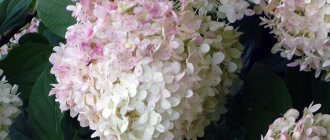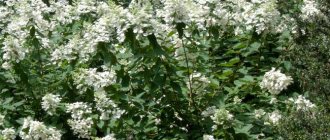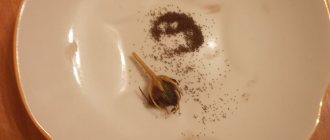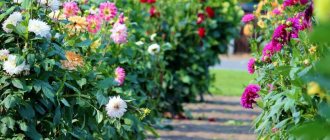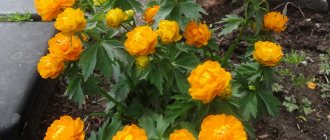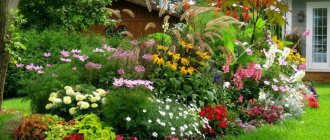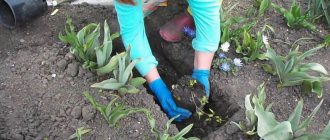Most types of mints (there are about 40 species and hybrids in total) are perennials with branched stems and simple aromatic leaves that can be pubescent. Various types and varieties of mint bloom from June to September with small, whitish or purple flowers collected in whorls or spike-shaped inflorescences.
- Origin of the name of the genus: Mint - Minta
- Cultivated species and varieties of mint for growing in gardens and pharmaceutical gardens Peppermint, cold mint or English mint, Mentha piperita
- Longleaf mint, Mentha longifolia
- Spearmint, Mentha spicata
- Round-leaved mint, or sweet mint, Mentha suaveolens
- Water mint, Mentha aquatica
Peppermint variety Grapefruit
Pepper
Peppermint or English mint was created by crossing wild species (mint arvensis and wild mint) in England in the 17th century. The name pepper is explained by the presence of a burning taste of the leaves of the plant.
A perennial herbaceous medicinal plant with a pleasant aroma. There are more than 100 types of mint.
Chocolate
Perennial herbaceous plant . A subspecies of peppermint. The leaves are simple, elongated with serrated edges of a purple hue. The leaves have a light chocolate aroma. The stem is tubular, 60-120 centimeters high. The inflorescences are white-pink, less often purple or lilac. Blooms from June to August. Loves lighted areas, but also grows in the shade. Requires watering. Grows everywhere. Used for making tea and desserts. It is an excellent antiseptic and tonic.
Coleus
Tropical ornamental plant of the Lamiaceae family. The plant can act as a shrub, subshrub and annual herbaceous plant. The stems are tetrahedral, erect, 50-80 centimeters high. The leaves are serrated, broadly oval in shape, very brightly colored, velvety with various patterns of white-pink-green, bright red, dark brown, purple, violet. The flowers are located at the top of the plant in the shape of a complex spike. Coleus love bright light and plenty of watering with soft, warm water. They grow in countries with tropical climates. Widely used in medicine and as decoration for flower beds.
Mexican
A perennial plant with a pleasant spicy aroma of mint and anise. The stems reach a height of up to 1.5 meters. The leaves are ordinary oblong. The flowers are candle shaped. They come in white, violet and lilac colors. Flowering period
from mid-June to late autumn.
Curly
A perennial herbaceous hybrid plant with a pungent odor. The stem is densely leafy, with a height of 30 to 100 centimeters. The leaves are sessile on short petioles, curly, ovate, pubescent on both sides. The flowers are small, collected in false whorls, pink-purple in color. Flowering period from late June to late September. Grows in Ukraine and Crimea.
Growing mint
The simplest of all perennials, the natural species is meadow mint - a malicious but aromatic weed. The main thing in growing mint is to plant it immediately in the right place: for planting, choose a light (possibly in partial shade) area with loose and fertile soil. Water in hot weather and feed along with other garden crops.
Propagating mint is easy too! segments of rhizomes, rooted stolons and just seeds. Seedlings with a piece of the root system and stolons will take root at almost any time of the season. Just don't forget to water.
Mint stolons that can be used for rooting. It is because of their presence that mint often turns from a pleasant aromatic guest into a tough aggressor, which has to be monitored and limited all the time.
Room
There are several popular varieties of indoor mint. It is grown at home as an unusual flower. Some varieties can be freely used for culinary purposes.
Prayer tree
Perennial houseplant in the form of a shrub. Evergreen. The stem is thin, well branched, reaching a length of 1 meter. The leaves are small, pubescent, with a subtle pleasant scent. The edges of the leaves are carved. The flowers are ordinary purple in color, collected in inflorescences. The plant is light-loving. At room temperature it blooms all year round.
Scandinavian ivy
Indoor herbaceous plant
with lodging shoots. The stem is creeping. Reaches 1 meter in length. The leaves are rounded at the edges, jagged, green in color with a shiny tint. Not picky, grows in any climatic conditions.
Plectranthus Ertendahl
The houseplant is exclusively decorative in the form of a subshrub. Stems are erect and up to 1 meter high. The leaves are velvety bright green on one side and purple on the other. Blooms profusely. The flowers are collected in white false whorls.
Origin of the name of the genus: Mint - Minta
The name of the genus Mint originates from the name of the nymph of the Cokytos River Minta (or Mintha, also Menta). The Minti Mountains in Triphylia in southern Elis are also named after her. Legend has it that Minta was the concubine of Hades, who abandoned her and made Persephone, daughter of Demeter, the goddess of fertility, his wife. But Minta did not want to give up, scolded and complained about her rival, for which she was trampled by Demeter, who loved her daughter very much. At the site of the death of the nymph, mint grew. By the way, the Greeks used mint in funeral rites.
Doggystyle
perennial herbaceous plant
with creeping rhizome. The stem is pubescent, branched, tetrahedral, up to 60 centimeters high. The leaves are paired, opposite, long-petiolate, rounded-heart-shaped with a strong unpleasant odor. It blooms blue, light purple, less often reddish or white. The flowers are tubular, two-lipped, collected in whorls of several pieces. Flowering period from June to August. Grows in the European part of Russia, the Caucasus, Central Asia and Kazakhstan.
Composition of mint essential oil
Plants of the Mint genus differ significantly in their chemical composition. In general, plants contain essential oil (peppermint oil), tannins and resins, carotene, hesperidin, ascorbic and other acids. The oil is colorless with a refreshing taste and aroma.
It was previously believed that the smell of mint stimulated the brain, so students of medieval universities were recommended to wear wreaths made from this plant.
Mint is harvested starting in May and ending in September. Before flowering, mint can be cut at the root and used whole. When the mint blooms, only the leaves are collected for drying.
Longifolia
Perennial tall soft fluffy herbaceous plant. The whole plant has a grayish tint. The stem is branched, erect, slightly pubescent, reaching a height of 120 centimeters. The leaves are sessile, lanceolate, ovate, up to 20 centimeters long. Contains vitamin C, succinic, citric and malic acids. Whorls of small light purple flowers are collected in dense cylindrical spikes. Blooms in June-August. Grows in Africa, Asia, throughout Europe, in the North Caucasus.
Using mint in garden design
Despite the fact that modern varieties of mint have very beautiful leaves, its undeniable advantage remains its aroma. It is indispensable in “flower” gardens.
Mint easily “runs away” from the planting site, it is quite aggressive and can crowd out other plants, so it is recommended to plant it in containers. Tall barrels or buckets are perfect for this. There is an interesting folk way of planting mint: cut out the bottom (partially or completely) of an old wooden or plastic bucket. The bucket is dug into the garden bed so that the edges protrude about 5 cm. Soil is poured inside the wind and mint is planted. However, sooner or later, mint, as a rule, still runs away.
Disease and pest control
On mint plantings, the use of pesticides to protect against diseases and pests is strictly prohibited. Therefore, when growing mint, you need to comply with all the requirements of agricultural technology, carefully monitor the condition of the bushes during the growing season and carry out timely preventive measures.
Mint is susceptible to fungal diseases (powdery mildew, rust, etc.). To exclude the possibility of disease, you must:
- observe a sparse planting regime;
- carry out annual thinning of bushes;
- loosen plantings in a timely manner and keep them free of weeds;
- Do not flood the bushes when watering, keep the soil moist (avoid stagnation of water).
If, during an inspection of the bushes, diseased ones are identified, they are immediately removed and burned.
Of the pests, mint is often attacked by aphids, spider mites, mint flea beetles, leaf rollers, etc. The main measures boil down to a systematic inspection of the bushes and removal of their damaged parts. If the entire bush is affected, the latter is removed and burned.
As a preventive measure, mint can be sprinkled:
- soap solution;
- ash extract solution;
- aphids do not tolerate apple cider vinegar (a solution of 1 tablespoon of apple cider vinegar per 1 liter of water, mix and sprinkle on plants in cloudy weather);
- water infusion of horse sorrel roots or dandelion leaves (300-400 g of plant material per 10 liters of water, leave for 3 hours, strain).
The main condition when processing mint: the solution must be harmless to people and pets.
Cutting young stems with leaves can be done when the plants reach a height of 10-12 cm. © Mikey Sklar
Exotic varieties
While the description of the varieties listed above may be more or less known, the varieties discussed below are still exotic in our areas. But if watermint or longleaf mint are a little boring, and you want something new, below is a description of plants that can surprise you.
Korean mint
Another name for the culture is Tibetan lofant. Its homeland is Central Asia. The shrub is quite tall, from 80 to 125 cm. The leaves are oval, with sharp edges. Indeed, the look is similar to aniseed lofant, only the Tibetan flowers are exclusively white.
With the help of this plant, they get rid of dandruff, minimize the appearance of acne, and treat wounds, rashes and ulcers. The plant also helps normalize sleep and serves as a remedy that helps to relax and relieve fatigue. A little Korean mint infusion is added to baths for bathing babies: it is believed that the baby falls asleep better after such “SPA treatments.”
Doggystyle
And it is otherwise called ivy-shaped budra. It grows almost everywhere: you can come across it in the garden, in the vegetable garden, and in the forest. Despite all its usefulness, the culture is highly toxic; methods of use for medicinal purposes must be agreed with a doctor.
A bronchial infusion is made from dog mint. If you overdo it with the dosage or drink infusions or decoctions for several days in a row, flu-like symptoms will appear. It is also considered an anthelmintic. People call dognip “forty-day mint,” but its effect can be excessive; caution is needed.
Beneficial features
The plant is grown not for its beautiful appearance or aroma, but for the benefits it brings to humans.
Benefit:
- helps get rid of inflammation of the respiratory tract;
- is an antispasmodic and antiseptic;
- helps in treating colds;
- reduces blood pressure levels;
- strengthens vision;
- has an analgesic effect;
- calms, reducing the level of anxiety and panic;
- helps to sleep;
- helps with angina pectoris;
- relieves pain in the stomach and intestines;
- has a choleretic effect;
- treats constipation and flatulence;
- relieves headaches;
- improves appetite and much more.
There is a lot of talk about the benefits of this plant. In its pure form, mint is useful. In addition, it is used as a flavorful additive to bitter mixtures and medicines.
It is undesirable to use:
- children under 3 years old;
- patients with hypotension;
- people with individual intolerance;
- mothers during lactation.
The use of mint causes infertility and varicose veins, so you should consult your doctor before using it.
How to choose and where to buy mint?
Pharmaceutical mint
It is advisable to harvest mint in person, especially due to the simple technology. But sometimes this is not possible for various reasons. Then you can buy a plant based on the following factors:
- Give preference exclusively to opaque containers or packs, as exposure to direct sunlight causes mint to lose its aroma and color.
- Mint packaging should be opaque.
- Ask the seller about how mint is stored and whether the basic conditions are met. Of course, it is impossible to track the entire storage period of the spice, but pay attention to all the details. Dried mint should not be left in the sun or in a transparent or sealed bag.
Keep in mind that dried mint has the same bright green color and rich aroma as the fresh product. A slight loss of color is allowed and no more. A pale or weak-smelling spice indicates improper storage; it is best to give preference to a product from another manufacturer.
Advice! You should not buy a product if the packaging is torn or even opened. Most likely, the spice has already lost its amazing aroma.
A little history
The history of mint goes back to past centuries, where its study became a discovery for humanity. The spicy-fragrant plant has more than 10 varieties and it originated from more than one continent. It is known that the plant grows in different climacteric zones and territories of the globe.
For example: mint grew in Egypt, the Mediterranean Sea, China, England and Greece. The study of mint first began to appear in Ancient Greece, where the name “Menthe” - “Mint” from the ancient Greek language - came from. The Greeks considered the fragrant plant a real deity and used it in various cults.
Sweet mint has found very wide application for various ailments. This plant helped improve mood, body tone, digestion and refreshed the mind well. The process of rubbing the walls and corners of the house with fresh mint became a traditional cult among the Romans.
This ritual was performed to receive guests into the house and visitors to churches. The Chinese also idolized mint due to the healing properties of this plant. Particular attention was paid to its calming and relaxing properties. Currently, mint is found almost throughout the globe.
Its most common type is considered to be “Peppermint”, which is also found in Russia. It is worth noting about the varieties of this healing plant. Many varieties are divided into different categories and are used for specific areas.
There are individual medicinal varieties of mint for making medicines. Also, other varieties are intended as fragrant additives and esters for cosmetic and hygiene lines.
But some varieties are medicinal as drinks and food seasonings. To study a particular variety, it is worth familiarizing yourself with all varieties of a given plant.
Description
Plectranthus does not require special care. It grows actively at home all year round. It has long and flexible shoots. If it is planted in a pot, the length of the stem reaches about eighty centimeters in an adult. Foliage is the same size.
Depending on the type, it comes with or without a pattern. Exudes a pleasant mint aroma. Very useful in areas where moths appear. The smell of Plectranthus repels insects. Indoor mint blooms in the summer. The inflorescence is lush. The flowers are bisexual, the color is lilac, purple, white or blue. After the fruits ripen, they open and four nuts are formed inside.
About the plant
The plant has a wide distribution. Used in cooking, cosmetology, medicine and other industries. Most varieties contain large amounts of menthol and have a strong odor. The plants are perennial and prefer cultivated soil. They are not picky about care and do not require fertilizing or frequent watering. They reproduce by roots, leaves and seeds.
When growing mint on the site, you should not plant it in the ground. It is better to limit it to a container, then the roots will not extend beyond the limited area. All parts of the plant, flowers, leaves, stems and roots are used. The leaves are collected after the plant has finished flowering. Dry and put in glass containers. The spice is grown on an industrial scale and is used in many industries.
Traditional medicine recipes
Diseases of the heart and nervous system
1 tsp pour 200 ml of leaves. boiling water Cover with a lid, wrap and leave for half an hour. Strain, squeeze out the raw materials.
Take 1/2 tbsp. three times a day before meals.
The infusion is prescribed for nervous disorders, insomnia, angina pectoris, and also to improve heart function.
Gastritis
Make a collection of 4 parts (by weight) peppermint (leaf) and 1 part centaury (herb).
2 tsp collection pour 200 ml. boiling water Cover with a lid, insulate and let sit until warm. Strain, squeeze out the raw materials.
Take 1 tbsp. three times a day half an hour before meals.
The infusion is drunk to treat gastritis with high acidity, in the presence of pain in the liver area.
Bloody vomiting
1 tbsp. mint pour 200 ml. boiling apple cider vinegar. Cover with a lid, wrap and leave for 40 minutes. Strain, squeeze out the raw materials.
Take 1-2 tsp. once or twice a day.
